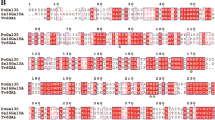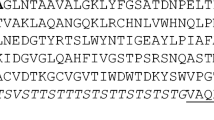Abstract
The polysaccharides of galactose present in the pectin of the plant cell wall are degraded by endo-β-1,4-galactanases. The filamentous fungus Penicillium purpurogenum, which grows on a number of natural carbon sources, among them sugar beet pulp which contains pectin, has a gene (ppgal1) coding an endo-β-1,4-galactanase (PpGAL1). This enzyme was expressed heterologously in Pichia pastoris. It has a molecular mass of 38 kDa, a pH optimum of 4–4.5, and an optimal temperature of 60 °C. It is 100 % stable for up to 24 h at pH 4–4.5 and 40 °C. These stability properties, which exceed those from other endo-β-1,4-galactanases reported to date, make it particularly suitable for industrial processes requiring acidic conditions and temperatures up to 40 °C. PpGAL1 is, therefore, a potentially effective tool in the food industry and in other biotechnological applications.







Similar content being viewed by others
References
Voragen, A. G. J., Coenen, G. J., Verhoef, R. P., & Schols, H. (2009). Pectin, a versatile polysaccharide present in plant cell walls. Structural Chemistry, 20, 263–275.
Sakamoto, T., & Ishimaru, M. (2013). Peculiarities and applications of galactanolytic enzymes that act on type I and II arabinogalactans. Applied Microbiology and Biotechnology, 9, 5201–5213.
Henrissat, B., & Davies, G. J. (1997). Structural and sequence-based classification of glycoside hydrolases. Current Opinion in Structural Biology, 7, 637–644.
Lombard, V., Ramulu, H. G., Drula, E., Coutinho, P. M., & Henrissat, B. (2014). The carbohydrate-active enzymes database (CAZy) in 2013. Nucleic Acids Research, 42, D490–D495.
Ryttersgaard, C., Lo Leggio, L., Coutinho, P. M., Henrissat, B., & Larsen, S. (2002). Aspergillus aculeatus β-1,4-galactanase: substrate recognition and relations to other glycoside hydrolases in clan GH-A. Biochemistry, 41, 15135–15143.
Ryttersgaard, C., Le Nours, J., Lo Leggio, L., Jørgensen, C. T., Christensen, L. L. H., Bjørnvad, M., & Larsen, S. (2004). The structure of endo-β-1,4-galactanase from Bacillus licheniformis in complex with two oligosaccharide products. Journal of Molecular Biology, 341, 107–117.
Otten, H., Michalak, M., Mikkelsen, J. D., & Larsen, D. (2013). The binding of zinc ions to Emericella nidulans endo-beta-1,4-galactanase is essential for crystal formation. Acta Crystallographica. Section F, Structural Biology and Crystallization Communications, 69, 850–854.
Le Nours, J., Ryttersgaard, C., Lo Leggio, L., Østergaard, P. R., Borchert, T. V., Christensen, L. L. H., & Larsen, S. (2003). Structure of two fungal β-1,4- galactanases: searching for the basis for and pH optimum. Protein Science, 12, 1195–1204.
Braithwaite, K. L., Barna, T., Spurway, T. D., Charnock, S. J., Black, G. W., Hughes, N., Lakey, J. H., Virden, R., Hazlewood, G. P., Henrissat, B., & Gilbert, H. J. (1997). Evidence that galactanases from Pseudomonas fluorescens subspecies cellulosa is a retaining family 53 glycosyl hydrolase in which E161 and E270 are the catalytic residues. The Biochemical Journal, 36, 15489–15500.
Yang, H., Ichinose, H., Yoshida, M., Nakajima, M., Kobayashi, H., & Kaneko, S. (2006). Characterization of a thermostable endo-β-1,4-D-galactanase from the hyperthermophile Thermotoga maritima. Bioscience, Biotechnology, and Biochemistry, 70, 538–541.
Larsen, D. M., Nyffenegger, C., Swiniarska, M. M., Thygesen, A., Strube, M. L., Meyer, A. S., & Mikkelsen, J. D. (2014). Thermostability enhancement of an endo-1, 4-β-galactanase from Talaromyces stipitatus by site-directed mutagenesis. Applied Microbiology and Biotechnology, 99, 4245–4253.
Fujimoto, H., Nakano, H., Isomura, M., Kitahata, S., & Ajisaka, K. (1997). Enzymatic Synthesis of oligosaccharides containing Gal β→4Gal disaccharide at the non-reducing end using β-galactanase from Penicillium citrinum. Bioscience, Biotechnology, and Biochemistry, 61, 1258–1261.
Van Laere, K., & Wissing, J. (2002). Nutritional composition with health promoting action containing oligo-saccharides. Patent: WO2002051264A2.
Ni, Y., Yates, K. M., & Zarzycki, R. (1999). Aloe pectins. Patent: US5929051A.
Fanaro, S., Boehm, G., Garssen, J., Knol, J., Mosca, F., Stahl, B., & Vigi, V. (2005). Galacto‐oligosaccharides and long‐chain fructo‐oligosaccharides as prebiotics in infant formulas: a review. Acta Paediatrica, 94, 22–26.
Michalak, M., Thomassen, L. V., Roytio, H., Ouwehand, A. C., Meyer, A. S., & Mikkelsen, J. D. (2012). Expression and characterization of an endo-1,4-β-galactanase from Emericella nidulans in Pichia pastoris for enzymatic design of potentially prebiotic oligosaccharides from potato galactans. Enzyme and Microbial Technology, 50, 121–129.
Heldt-Hansen, H. P., Kofod, L. V., Budolfsen, G., Nielsen, P. M., Hüttel, S., & Bladt, T. (1996). Application of tailormade pectinases. Progress in Biotechnology, 14, 463–474.
Hwang, J., Pyun, Y. R., & Kokini, J. L. (1993). Side chains of pectins: some thoughts on their role in plant cell walls and foods. Food Hydrocolloids, 7, 39–53.
Sørensen, S. O., Pauly, M., Bush, M., Skjøt, M., McCann, M. C., Borkhardt, B., & Ulvskov, P. (2000). Pectin engineering: modification of potato pectin by in vivo expression of an endo-β-1,4-D-galactanase. Proceedings of the National Academy of Sciences of the United States of America, 97, 7639–7644.
Batie, C. J., Crabb, G., Aux, G. W., Cates, E. S., Dinwiddie, J. A., Silverstone, A. R., Quadt, R., & Miller; C. A. (2008). Process for starch liquefaction and fermentation. Patent: US20080299256A1.
Wietgrefe, G., & Bregger, T. (2013). Systems and processes for producing biofuels from biomass. Patent US20130052709A1.
Eisele, T. A., & Drake, S. R. (2005). The partial compositional characteristics of apple juice from 175 apple varieties. Journal of Food Composition and Analysis, 18, 213–221.
Hurdequint, L., Hurdequint, P., & Ducroo, P. (1994). Method for controlled enzymatic retting of bast fibres and enzymatic retting solution. Patent: WO1994013868A1.
Chereau, D., Decock, B., Fourtot-Brun, C., Lefevre, J., & Petrich-Murray, H. (1995). Enzymatic retting method. Patent: WO1995016808A1.
Knap, I. H., Kofod, L. V., & Ohmann, A. (1997). Animal feed additives. Patent: WO1997016982A1.
Lassen, S. F., Sjoeholm, C., Oestergaard, P, R., & Fischer, M. (2008). Proteases. Patent: US20080286415A1.
Johansen, C. (1998). A method for enzymatic treatment of biofilm. Patent: WO1998026807A1.
Shirai, T., Ishida, H., Noda, J. I., Yamane, T., Ozaki, K., Hakamada, Y., & Ito, S. (2001). Crystal structure of alkaline cellulase K: insight into the alkaline adaptation of an industrial enzyme. Journal of Molecular Biology, 310, 1079–1087.
Ralet, M. C., Thibault, J. F., & Della Valle, G. (1991). Solubilization of sugar-beet pulp cell wall polysaccharides by extrusion cooking. Lebensmittel-Wissenschaft und Technologie, 24, 107–112.
Hidalgo, M., Steiner, J., & Eyzaguirre, J. (1992). β-Glucosidase from Penicillium purpurogenum: purification and properties. Biotechnology and Applied Biochemistry, 15, 185–191.
Miller, G. L. (1959). Use of dinitrosalicylic acid reagent for determination of reducing sugar. Analytical Chemistry, 1959(31), 426–428.
Rabiu, B. A., Jay, A. J., Gibson, G. R., & Rastall, R. A. (2001). Synthesis and fermentation properties of novel galacto-oligosaccharides by β-galactosidases from Bifidobacterium species. Applied and Environmental Microbiology, 67, 2526–2530.
González-Vogel, A., Eyzaguirre, J., Oleas, G., Callegari, E., & Navarrete, M. (2011). Proteomic analysis in non-denaturing condition of the secretome reveals the presence of multienzyme complexes in Penicillium purpurogenum. Applied Microbiology and Biotechnology, 89, 145–155.
Tamura, K., Stecher, G., Peterson, D., Filipski, A., & Kumar, S. (2013). MEGA6: molecular evolutionary genetics analysis version 6.0. Molecular Biology and Evolution, 30, 2725–2729.
Saitou, N., & Nei, M. (1987). The neighbor-joining method: a new method for reconstructing phylogenetic trees. Molecular Biology and Evolution, 4, 406–425.
Nei, M., & Kumar, S. (2000). Molecular evolution and phylogenetics. New York: Oxford University Press.
Yin, Y., Mao, X., Yang, J. C., Chen, X., Mao, F., & Xu, Y. (2012). dbCAN: a web resource for automated carbohydrate-active enzyme annotation. Nucleic Acids Research, 40, 445–451.
Nakano, H., Takenishi, S., & Watanabe, Y. (1985). Purification and properties of two galactanases from Penicillium citrinum. Agricultural and Biological Chemistry, 49, 3445–3454.
Sakamoto, T., Nishimura, Y., Makino, Y., Sunagawa, Y., & Harada, N. (2013). Biochemical characterization of a GH53 endo-β-1,4-galactanase and a GH35 exo-β-1,4-galactanase from Penicillium chrysogenum. Applied Microbiology and Biotechnology, 97, 2895–2906.
Saulnier, L., & Thibault, J. F. (1999). Ferulic acid and diferulic acids as components of sugar-beet pectins and maize bran heteroxylans. Journal of the Science of Food and Agriculture, 79, 396–402.
de Vries, R. P., Pařenicová, L., Hinz, S. W., Kester, H., Beldman, G., Benen, J. A., & Visser, J. (2002). The β‐1,4‐endogalactanase A gene from Aspergillus niger is specifically induced on arabinose and galacturonic acid and plays an important role in the degradation of pectic hairy regions. European Journal of Biochemistry, 269, 4985–4993.
Niu, J., Homan, T. G., Arentshorst, M., de Vries, R. P., Visser, J., & Ram, A. F. (2015). The interaction of induction and repression mechanisms in the regulation of galacturonic acid-induced genes in Aspergillus niger. Fungal Genetics and Biology, 82, 32–42.
Higgins, D. R., & Cregg, J. M. (1998). Introduction to Pichia pastoris. In D. R. Higgins & J. M. Cregg (Eds.), Methods in molecular biology. Vol. 103: Pichia protocols (pp. 8–10). Totowa: Humana press.
Bornhorst, J. A., & Falke, J. J. (2000). Purification of proteins using polyhistidine affinity tags. Methods in Enzymology, 326, 245–254.
Fu, J., Prade, R., & Mort, A. (2001). Expression and action pattern of Botryotinia fuckeliana (Botrytis cinerea) rhamnogalacturonan hydrolase in Pichia pastoris. Carbohydrate Research, 330, 73–81.
Dutta, S., & Wu, K. C. W. (2014). Enzymatic breakdown of biomass: enzyme active sites, immobilization, and biofuel production. Green Chemistry, 16, 4615–4626.
Kaya, M., Sousa, A. G., Crépeau, M. J., Sørensen, S. O., & Ralet, M. C. (2014). Characterization of citrus pectin samples extracted under different conditions: influence of acid type and pH of extraction. Annals of Botany, 114, 1319–1326.
Kimura, I., Yoshioka, N., & Tajima, S. (1998). Purification and characterization of an endo-1,4-β-D-galactanase from Aspergillus sojae. Journal of Fermentation and Bioengineering, 85, 48–52.
van de Vis, J. W., Searle-van Leeuwen, M. J. F., Siliha, H. A., Kormelink, F. J. M., & Voragen, A. G. J. (1991). Purification and characterization of endo-1,4-β-D-galactanases from Aspergillus niger and Aspergillus aculeatus: use in combination with arabinases from Aspergillus niger in enzymic conversion of potato arabinogalactan. Carbohydrate Polymers, 16, 167–187.
Kikuchi, T., Jones, J. T., Aikawa, T., Kosaka, H., & Ogura, N. (2004). A family of glycosyl hydrolase family 45 cellulases from the pine wood nematode Bursaphelenchus xylophilus. FEBS Letters, 572, 201–205.
van den Brink, J., & de Vries, R. P. (2011). Fungal enzyme sets for plant polysaccharide degradation. Applied Microbiology and Biotechnology, 91, 1477–1492.
Labavitch, J. M., Freeman, L. E., & Albersheim, P. (1976). Structure of plant cell walls. Purification and characterization of a β-1,4-galactanase which degrades a structural component of the primary cell walls of dicots. The Journal of Biological Chemistry, 251, 5904–5910.
Payne, C. M., Bomble, Y. J., Taylor, C. B., McCabe, C., Himmel, M. E., Crowley, M. F., & Beckham, G. T. (2001). Multiple functions of aromatic-carbohydrate interactions in a processive cellulase examined with molecular simulation. The Journal of Biological Chemistry, 286, 41028–41035.
Davies, G., & Henrissat, B. (1995). Structures and mechanisms of glycosyl hydrolases. Structure, 3, 853–859.
Acknowledgments
This work has been supported by grants from FONDECYT (1130180), Universidad Andrés Bello (DI-478-14/R and DI-31-12/R)
Author information
Authors and Affiliations
Corresponding author
Ethics declarations
Conflict of Interest
The authors declare that they have no competing interests.
Electronic supplementary material
Below is the link to the electronic supplementary material.
Fig. S1
Analysis of the ppgal1 promoter. The GARE element (5′ TCCNCCAAT 3′) at -693 is highlighted in green. CREA binding sites at -353, -396, -503, -779, -784, -839 are shown in yellow. G underlined indicates a nucleotide shared by two CREA binding sites. (DOC 30 kb)
Fig. S2
Identification of the GARE element in fungal promoters. The GARE element (5′ TCCNCCAAT 3′), in green, is found in the promoters of the endo-β-1,4-galactanase gen of A. aculeatus (-335), A. niger (-299), E. nidulans (-195), P. chrysogenum (-346) and T. stipitatus (-154). Purple background indicates a nucleotide not conserved in GARE. (DOC 36 kb)
Fig. S3
Model of the molecular surface of the PpGAL1. a. Side view of the model. b. Front view of the model. The acid/base residue (Glu156) is indicated in yellow and the nucleophilic residue (Glu 267) in green. The image was obtained by means of the Swiss-PDB Viewer program. (DOCX 202 kb)
Table S1
(DOCX 476 kb)
Rights and permissions
About this article
Cite this article
Zavaleta, V., Eyzaguirre, J. Penicillium purpurogenum produces a highly stable endo-β-(1,4)-galactanase. Appl Biochem Biotechnol 180, 1313–1327 (2016). https://doi.org/10.1007/s12010-016-2169-6
Received:
Accepted:
Published:
Issue Date:
DOI: https://doi.org/10.1007/s12010-016-2169-6




